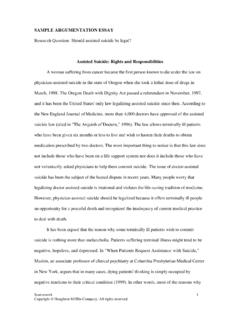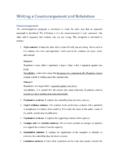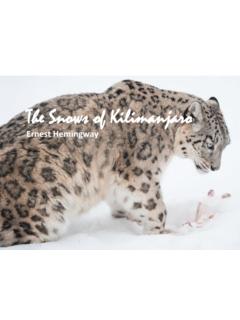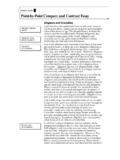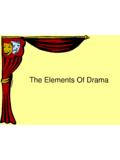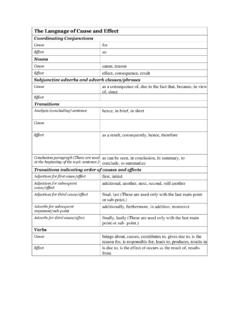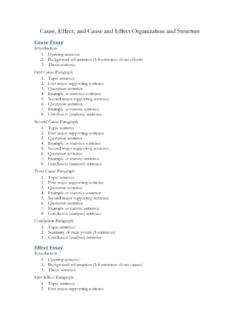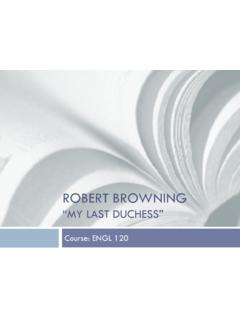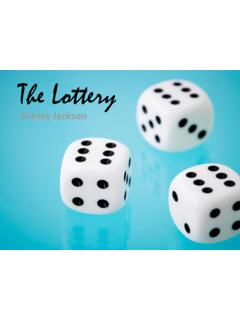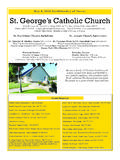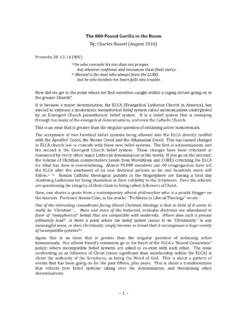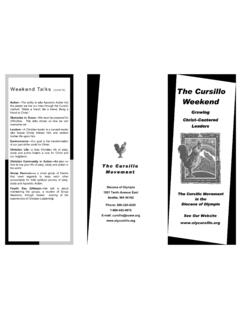Transcription of Good Country People - eluprogram.com
1 good Country People Flannery O'Connor Flannery O'Connor: The Moral Voice of the South All human 1925-1964. nature Regarding her emphasis of the grotesque, O'Connor said: vigorously resists Anything that comes out of grace because the South is going to be called grace changes us grotesque by the Northern and the change reader, unless it is grotesque, in which case it is going to be is painful. called realistic. [. - Flannery O'Connor Mary Flannery O'Connor was born in Savannah, Georgia. An important voice in American literature, she wrote two novels and 32 short stories, as well as a number of reviews and commentaries. She was a Southern writer who often wrote in a Southern Gothic style and relied heavily on regional settings and grotesque characters. O'Connor's writing also reflected her own Roman Catholic faith and frequently examined questions of morality and ethics.]
2 Flannery O'Connor (1925-1964). Genre: Novel, short story, essay Movement: Southern Gothic Awards: Three O'Henry awards for short fiction Novels: 1. Wise Blood (1952). 2. The Violent Bear It Away (1960). Short Story Collections: 1. A good Man Is Hard to Find (1955). 2. Everything That Rises Must Converge The only thing that keeps me from being a regional writer is being a Catholic and the only (1965), published posthumously thing that keeps me from being a Catholic writer (in the narrow sense) is being a Southerner.. 3. The Complete Stories (1971), published Flannery O'Connor posthumously Literary Context Southern Gothic is a subgenre of Gothic fiction unique to American literature that takes place exclusively in the American South. It resembles its parent genre in that it relies on supernatural, ironic, or unusual events to guide the plot.
3 It is unlike its parent genre in that it uses these tools not solely for the sake of suspense but to explore social issues and reveal the cultural character of the American South. The Southern Gothic style is one that employs the use of macabre, ironic events to examine the values of the American South. While English Gothicism closely paralleled the Romantic Movement in literature, frequently focusing on issues of love, sexuality, and the place of reason in human existence, Southern Gothic fiction focuses largely on themes of terror, death, and social interaction. Certain scholars such as Leslie Fiedler in Love and Death in the American Novel (1960) have identified specifically national concerns apparent in Southern Gothic fiction, particularly the relationships between races and genders. Literary Context (cont.)
4 Flannery O'Connor occupies a unique place in the Southern Gothic movement. With the exception of a number of her early stories, O'Connor consistently produced fiction having an implicit, if not a totally explicit, religious world view as an integral element of each work. As a writer with professedly Christian concerns, O'Connor was, throughout her writing career, convinced that the majority of her audience did not share her basic viewpoint and was, if not openly hostile to it, at best indifferent. In order to reach such an audience, O'Connor felt that she had to make the basic distortions of a world separated from the original, divine plan "appear as distortions to an audience which is used to seeing them as natural." This she accomplished by resorting to the grotesque in her fiction. To the "true believer," the "ultimate grotesqueness" is found in those post-lapsarian (after the Fall) individuals who ignore their proper relationship to God and either rebel against Him or deny that they have any need to rely upon Him for help in this life.
5 Joy/Hulga Hopewell belongs in this second class. Literary Context (cont.). To make these individuals appear grotesque to the secular humanist (one who argues that humans can, by their own ingenuity and wisdom, make a paradise of this earth, if given sufficient time), O'Connor creates, for example, the psychopathic killer, the pious fraud, or the physical or intellectual cripple. This display of what some critics have labeled the "gratuitous grotesque" became for O'Connor the means by which she hoped to capture the attention of her audience. She wrote in a very early essay that "when you can assume that your audience holds the same beliefs you do, you can relax a little and use more normal means of talking to it; when you have to assume that it does not, then you have to make your vision apparent by shock to the hard of hearing you shout, and for the almost-blind you draw large and startling figures.
6 " For O'Connor, writing was a long, continuous shout. In Mystery and Manners, O'Connor writes, There is a moment in every great story in which the presence of grace can be felt as it waits to be accepted or rejected even though the reader may not recognize this moment.. Literary Context (cont.). At another point, she comments, From my own experience in trying to make stories 'work,' I have discovered that what is needed is an action that is totally unexpected, yet totally believable, and I have found that, for me, this is always an action which indicates that grace has been offered. And frequently it is an action in which the devil has been the unwilling instrument of grace.. Loosely defined, Illuminating Grace (the type of grace most frequently used by O'Connor in her stories) may be described as a gift, freely given by God, which is designed to enlighten the minds of People and help them toward eternal life.
7 It may take the form of some natural mental experience, such as a dream or viewing a beautiful sunset, or of some experience imposed from outside the individual for example, from hearing a sermon or from experiencing an intense joy, a sorrow, or some other shock. Literary Context (cont.). Man, having been given free will, may, according to the Catholic position, elect not to accept the gift of grace, as opposed to a Calvinist position, which argues for a concept of Irresistible Grace that is, man cannot reject God's grace when it is given to him. Even though O'Connor notes that she looks for the moment in which the presence of grace can be felt as it waits to be accepted or rejected, one should not assume that she is attempting to pass judgment on the ultimate fate of her characters. That, from an orthodox point of view, is not possible for man to do.
8 Even though O'Connor's vision was essentially religious, she chose to present it from a primarily comic or grotesque perspective. good Country People Analysis good Country People Characters Mrs. Freeman Woman who lives next door to Mrs. Hopewell and works for Mrs. Hopewell as a tenant farmer Glynese Freeman Mrs. Freeman's daughter, eighteen with many admirers . Carramae Freeman Mrs. Freeman's daughter, fifteen but married and pregnant Mrs. Hopewell A divorc e, owner of a farm, and the mother of Joy/Hulga Joy/Hulga Hopewell Mrs. Hopewell's thirty-two-year- old daughter with a PhD and a wooden leg Manley Pointer A door-to-door Bible salesman good Country People Style This story is divided into four rather distinct sections which help emphasize the relationships between the four central characters.
9 By dividing the story into four loosely distinct sections, O'Connor is able to establish subtle parallels between the characters of Mrs. Freeman and Manley Pointer and between Mrs. Hopewell and her daughter, Joy/Hulga, while at the same time providing details which appear to emphasize the different facets of the four individual characters. For example, O'Connor uses the day of Joy's/Hulga's "enlightenment" in order to create parallels between Mrs. Freeman and Manley Pointer, while the flashbacks to the events of the previous day establish the parallels which exist between Joy/Hulga and her mother. good Country People good Country People takes place on a tenant farm in Setting Georgia, which O'Connor uses to establish a worldview that is narrow as well as hierarchical, for Mrs. Hopewell owns the farm while Mrs.
10 Freeman works on it, appropriately entering Mrs. Hopewell's house by way of the kitchen door. Dialect contributes to a verisimilitude of setting. For example, a man's comment about Mrs. Freeman, If she don't get there before the dust settles, you can bet she's dead, . captures the idiom of the rural South. When Manley Pointer tells Mrs. Hopewell, I know you believe in Christian service, he communicates a limited Christianity based on words rather than true belief, which is important to People who live there. Manley's walking across the meadow at the end of the story provides another detail of setting. When she sees him, Mrs. Freeman observes that he must have been selling *Bibles+ to the Negroes back in the woods behind Mrs. Hopewell's farm, linking social hierarchy, race, and religion to the rural South of the 1950s.
